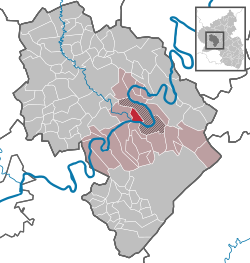Lieser, Germany
| Lieser | ||
|---|---|---|
|
||
| Coordinates: 49°55′2″N 7°1′19″E / 49.91722°N 7.02194°ECoordinates: 49°55′2″N 7°1′19″E / 49.91722°N 7.02194°E | ||
| Country | Germany | |
| State | Rhineland-Palatinate | |
| District | Bernkastel-Wittlich | |
| Municipal assoc. | Bernkastel-Kues | |
| Government | ||
| • Mayor | Reinhard Barthen | |
| Area | ||
| • Total | 5.42 km2 (2.09 sq mi) | |
| Elevation | 117 m (384 ft) | |
| Population (2015-12-31) | ||
| • Total | 1,233 | |
| • Density | 230/km2 (590/sq mi) | |
| Time zone | CET/CEST (UTC+1/+2) | |
| Postal codes | 54470 | |
| Dialling codes | 06531 | |
| Vehicle registration | WIL | |
| Website | www.lieser-mosel.de | |
Lieser is an Ortsgemeinde – a municipality belonging to a Verbandsgemeinde, a kind of collective municipality – in the Bernkastel-Wittlich district in Rhineland-Palatinate, Germany.
Lieser belongs to the Verbandsgemeinde of Bernkastel-Kues, whose seat is in the like-named town. It lies on the Middle Moselle and is named after the river Lieserbach, which empties into the Moselle west of Lieser. The village is shaped like an upside-down T (when viewed from the south) as many houses have been built below the vineyards, along the Moselle’s bank. The older part of the lower village exhibits tight terraced housing development with vineyards lying behind, owing to the intensive winegrowing. Rising up over the village is the Late Baroque Saint Peter’s Parish Church (Pfarrkirche St. Peter)
Archaeological finds reveal that settlement history reaches back to Roman times. Witnessing this are the remnants of a Roman aqueduct on the Paulsberg (mountain) above Lieser, surface finds of Roman tiles and a Roman winepressing facility unearthed in 2005 during roadworks at the riverbank. This lay below the vineyards, some 500 m east of the village, but after an emergency excavation, it was filled in again.
In 817, the village had its first documentary mention as Lisura. According to documents from 1085 and 1165, a great part of the land in Lieser belonged “together with the church and its tithes, vineyards and cropfields…” to the Abbey of Saint-Hubert, which was subordinate to the Prince-Bishopric of Liège (nowadays in Belgium). Alongside this, the Prince-Archbishop-Elector of Trier also had landholdings in Lieser about 1200. In 1575, the Abbey of Saint-Hubert sold its holdings to Prince-Archbishop-Elector of Trier Jakob III of Eltz. Further landholders were, among others, the Collegiate Foundations of St. Paulin and St. Simeon in Trier, as well as Himmerod Abbey. The villagers earned their livelihood mainly from winegrowing, and as tenants they had to pay tithes and other levies. Only at Secularization under Napoleon did the winemakers become the vineyard owners.
...
Wikipedia



